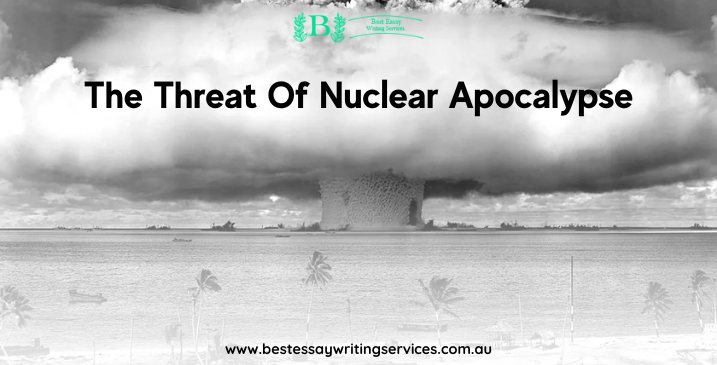On 30th January 2023, Russia signalled the renewal of the Nuclear-arms treaty: An internationally agreed treaty that restricts the construction and use of nuclear-armed weapons will depend on whether US accepts the defeat of Ukraine in ongoing war between Russia and Ukraine or not.
Global security, the entire arms control, has been leveraged by Russia for the strategic defeat of Ukraine in the war. If the treaty is not renewed, nuclear powers will not stop using the nukes at their convenience.
With political leaders not taking the adversities of nuclear power seriously, it seems that the true potential of nuclear power is still unknown. However, world war two was the first witness of the fragment of the potential of a nuclear weapon, where the mere thought of two detonated atomic bombs still shivers the souls of many Japanese.
It was 8:15 AM, 6th August 1945. The world has become a massive war zone for the past seven years. Millions dead, and many more were left injured. But unfortunately, nations neither had enough men nor funds to fuel the ongoing World War II that had been going on since 1939.
But for Japan, it was a peaceful morning, compared to other days, where gunshots and screams were the sounds people would wake up to. But, little did they know, this peace was the deafening silence before a deadly nuclear storm, something the world had never experienced.
To end the ongoing crises, the US army, out of no consideration for the aftermath, dropped a nuclear bomb on Hiroshima, a town tucked in Japan. Three days later, another nuclear bomb was dropped 120 miles away from Hiroshima. This time the victim was another city named Nagasaki.
More than 2, 00,000 people lost their lives to the atomic bombings. Many died on the spot; more died within a month. The horrors of physical ailments, abnormal or stillborn babies, and slow death due to radiation haunt people even today. As per a national survey in the US, this was the most noxious and the top headline of the entire twentieth century.
For the first time, a small fragment of the mammoth potential of nuclear power was revealed to the world.
Later, in 1986, in Germany, another nuclear disaster detonated in a nuclear power plant in Chernobyl. It was just another hint of the apocalypse this highly radioactive nuclear power was capable of.
However, these are not just the only two incidents of nuclear destruction, be it the Fukushima nuclear disaster of 2011 caused by floods or the recent loss of a radioactive penny-sized coin on a deserted road in Australia, threats of nuclear hazard have been continuously knocking on the doors.
But when will we wake up and open our eyes to the threats surrounding us? If not today, then when?
Nuclear weapons can wreak unparalleled devastation upon the world. Their explosive power is derived from the release of energy through nuclear reactions, which can result in widespread destruction and loss of life on a scale never seen before. The physical impact of a nuclear blast can include the obliteration of entire cities, with buildings collapsing, fires starting and power grids being knocked out.
Radiation released from a nuclear detonation can cause long-term environmental damage, as seen in Chernobyl, where all the trees and animals were slaughtered due to radiation exposure. Other than impacting the environment, radiation exposure could lead to serious health problems for those exposed, as well as genetic mutations that could affect future generations.
Did you know that Marie Qurie, the scientist behind the pioneering discovery in radioactivity, also died due to slow exposure to radiation?
The threat of nuclear apocalypse is so severe that atomic scientists in US claim that we are just 90 seconds away from global destruction.
In a recent press conference in Washington, US, the Atomic Science Organization set the hands of the symbolic “doomsday clock” to mere 90 seconds away from midnight. The clock is a metaphor for the remaining time to combat unprecedented danger to human survival. The tradition began in 1945, following the bombings of Hiroshima and Nagasaki in Japan.
Ever since the first specimen of the nuclear weapon’s potential was put to the test by America in the world war, the entire world was only astounded by the destruction but also the “secret mission” of America, under which more than 130000 people, at the expense of 2.2 billion USD, were working to build the nuclear weapons mutely. The project was named “The Manhattan Project”.
Although, World War 2 ended with Japan surrendering five days after the second bomb was dropped on Nagasaki. But, as the secret of America was out of the box, the world was posed with even a bigger set of problems; what to do with the nuclear genie that had come out of the bottle? Hence, the atomic science organization came into existence to contain the aftereffects of atomic destruction and to learn from mistakes.
Ever since 1945, the norms around harnessing the potential of nuclear power have been stricter. Today, nine superpowers, named the USA, Russia, China, India, Pakistan, Israel, France, North Korea and the United Kingdom, are invested in nuclear weapons.
The threat of a nuclear explosion is a haunting reality that has lingered over the world for decades. This destructive power, harnessed by splitting the atom, has the potential to wipe out entire cities and claim countless lives in mere seconds. Nuclear weapons have only happened twice in history, but the fear of their potential use has constantly shadowed international relations and global stability. The spread of nuclear technology and the lack of universal disarmament only amplify these fears, making the threat of a nuclear explosion a pressing concern for all nations.
The piling threats:
Russian war in Ukraine is the most recent threat that can bring about a nuclear apocalypse, a scientist at the atomic research centre said. We are closer to doomsday than ever before; if that is not alarming enough, we do not know what will be.
As of now, there are more than 13,000 nuclear nukes around the world, ready to detonate. Although, the number of warheads had decreased rapidly since the early 1970s and 1980s, when Russia and USA dominated the nukes market, with more than 30k and 22k nuclear weapon capacities. But, the threat of cold winter remains eminent because every one of the nukes is capable of causing first-degree burns to people sitting 10 kilometres away from the epicentre.
What will happen in case of nuclear war?
A full-scale nuclear war between two global superpowers, Russia and USA, which have more than 90% of global nuclear powers, would see production decline by more than 90 percent in two to three years after the war, according to the Federation of American Scientists (FAS).
A few hundred atomic bombs and the earth would become inhabitable for another million years, at least for humans. Even if you were fortunate enough to survive the initial blast, although very unlikely, you would die within the next month or a year due to hunger and exposure to radiation.
The entire planet will be covered in a black cloud of smoke for years, dropping the temperature and making the earth cooler. Then, to pile on that, the level of nuclear radiation will be so high that all the plants, animals and every living being will be drenched in radiation. Survival will, then, depend on the fittest.
The counteraction:
Scientists fear that the use of nuclear power has the potential to bring about catastrophic consequences for all of humanity. Hence, as a countermeasure, we have launched human-DNA-packed spacecraft into space to preserve human DNA in case of a nuclear apocalypse.
However, that is speaking on a macro level, what you should do in case of a nuclear attack:
- Cover your mouth with a cloth and rush inside. Concrete and brick walls are best.
- Stay away from windows and doors. Try to stay in the basement or ground floor of the building.
- Remove contaminated clothing and wipe off unprotected skin; prepare the first aid box.
- Do not come outside until local authorities say so.
- Relying on radio and battery-operated devices, cell phones, and TV might lose service.
Conclusion:
In a world where weapons of mass destruction are becoming more and more prevalent, we must exercise caution and take steps to prevent such a catastrophe from occurring. Whether through international agreements, inspections, or disarmament, we must act swiftly and decisively to ensure that the world remains safe from the devastating consequences of a nuclear explosion.
In conclusion, the threat of a nuclear explosion is a serious and pressing issue that requires immediate attention. We must act with caution and foresight to prevent such a tragedy. Only then can we ensure a future where our world is free from the threat of nuclear annihilation.
"Hire essay writers from BEWS with years of experience to earn a better grade and impress your parents."
Copyright © 2026 getessayservice.com

